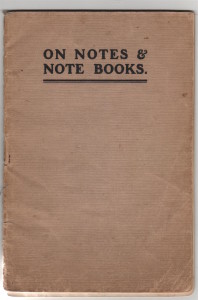 Now we are in the Digital Age, when as much data as we like can be stored in a note-book sized device made of plastic and metal, note-taking as a aid to memory is less important. As recent as fifteen years ago if we needed to record the gist of books, articles etc., we resorted to a note book made of paper and card which had to be small enough to be carried around in a pocket. In practice what we tended to do, however, was to write too much in too big a hand than was appropriate, thus making our notebook less efficient as a means of storing an accumulation of facts and opinions.
Now we are in the Digital Age, when as much data as we like can be stored in a note-book sized device made of plastic and metal, note-taking as a aid to memory is less important. As recent as fifteen years ago if we needed to record the gist of books, articles etc., we resorted to a note book made of paper and card which had to be small enough to be carried around in a pocket. In practice what we tended to do, however, was to write too much in too big a hand than was appropriate, thus making our notebook less efficient as a means of storing an accumulation of facts and opinions.
The solution, according to a self-published booklet of c 1934 entitled On Notes and Note Books by someone called David B. Muir of Dresden Road, Holloway, north London, was to accommodate more notes on literary material that interested us by reducing our hand to the size of newsprint, abbreviating words and compiling an index.
In Muir’s system of abbreviations a series of short straight or curved strokes above the missing letters, dots above and below, and other symbols for prefixes, would indicate the types of contractions intended. Discrete items of information would be separated by double or single vertical strokes. In the Index the keyword would be followed by a normal sized page number and a very small number, indicating the line. According to Muir, the secret to success with his system of note-taking lay in memorising these symbols plus any other symbols that the individual note-taker might care to use. Continue reading
